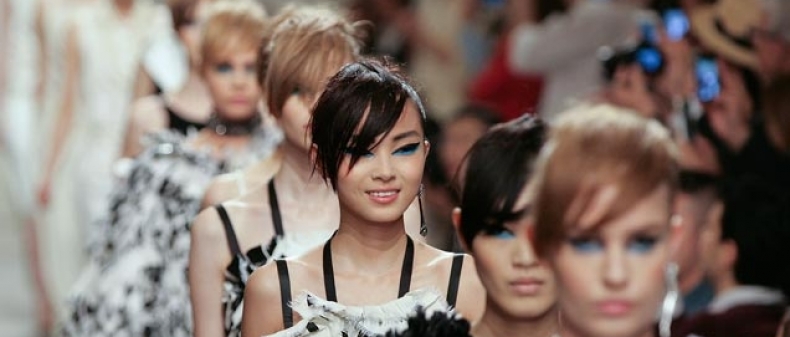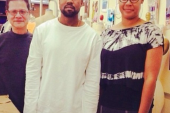
Just over 100 years ago, Gabrielle “Coco” Chanel opened her first hat shop in Deauville, France, catering to upper-crust types with more money than they knew what to do with. Fast forward to Chanel’s Cruise collection–shown in a former nutmeg plantation in Singapore–and all of those Chanel codes were there: the abundance of pearls, the embroidered (not woven, as Creative Director Karl Lagerfeld is quick to point out) tweeds, the camelias, and Chanel’s original restrained palette of black, white, navy and cream.
Unlike Karl’s usual cultural surveys–Shanghai, Russia, Bombay, Venice, Saint-Tropez, Scotland, and the Ottoman Empire have inspired previous collections–this show didn’t embrace all of the clichés of its inspiration. Sure, there were cricket bats, knee-guards and–if you looked closely–abstract minimalist prints drawn from traditional Singaporean fabrics, but, for the first time, one got the sense that Karl didn’t immerse himself (and the collection) in his host country, one with an incredibly rich cultural history to draw upon. Granted, that history is rife with British and Japanese histories of brutal colonialism, but with so much cultural text to work with, one wonders why Lagerfeld didn’t dive headfirst into Singaporean history. It points to a larger problem that Western fashion tends to run into when drawing inspiration from “foreign” countries: Given the international circulation of trends from all corners of the world, how do designers approach ethnic inspirations without entering fetishistic territory, or worse, satirizing an entire culture? Can designers take inspiration without being grossly racist and enforcing European aesthetics on everyone else?
Brad Kroenig for Chanel Cruise. Image via China DailyOne of the earliest contemporary examples of approaches to ethnic fashion was Yves Saint Laurent in the late 1960s, who was among the first to take inspiration from his travels in Africa and Asia, incorporating African-inspired wooden conical bras (later riffed on by Jean Paul Gaultier for Madonna), Persian rug prints, and the safari jacket into his earlier couture and RTW shows. With the shift from made-to-measure clothing to so-called “democratized” mass production (now known as ready-to-wear), the debut of Saint Laurent’s Rive Gauche label disseminated those designs to the masses who couldn’t afford YSL-proper. Subsequently, fashion was beginning to enter the mainstream with the supermodel era, and Saint Laurent made models of colour like Tina Chow, Beverley Peele, Veronica Webb, Pat Cleveland, Naomi Campbell, and Iman household names as the public’s interest in fashion exploded.
The cultural conversation was changing, and fashion along with it. Designers had to ask themselves, “Will this piece suit my woman in the Paris as well as it would in America, Milan, and London?” Merchandisers demanded versatility, and the seeds of globalization were beginning to take root. The most dominant force of that globalization was European fashion, specifically French fashion and their storied history of couture. Affluent clients were hungry for the Chanel and Versace that denoted taste and, more importantly, money.
Yves Saint Laurent’s “Africa” collection, 1987. Via AfricanityThis posed an interesting question for designers like Saint Laurent who were keen on introducing foreign cultures into the conversation: how do you make a foreign approach to making clothes commercially viable for a Eurocentric global market? The most obvious answer was translating it into the vernacular of the dominant European culture. Keep the African prints, but get rid of the traditional weaving techniques and replace them with French embroideries. That way, it doesn’t have all of the lower class connotations and becomes #lavished, right?
Commodifying other cultures to make them commercially viable watered down the visibility of their original artisans and creators. Foreign artisans who made samples for designer-tourists, to be taken back for mass production (certainly without paying royalties), watched their work–and subsequently, the symbols of their culture–be taken apart and disseminated to the masses, hungry for the exoticism of the ethnic.
The entire concept of ‘Resort’ then–a season invented by retailers to refresh their over-photographed, over-advertised inventory after three months rather than six–is centred on commercialism and travel, and by extension, this tourist gaze that’s obsessed with escaping the mundane and delighting in the foreign. In the industry, commercial viability translates into simpler fabrications and easier propositions instead of the experimental (or in industry speak, editorial) pieces in order to sell stock faster, while reinforcing the tourist (and ultimately capitalist) approach to consuming the ethnic and non-familiar.
Behind the scenes of Lagerfeld’s Cruise film Once Upon A Time. Image via Vogue Paris.Lagerfeld has often said that he prefers imagining the inspirations of his collections rather than researching them, giving him more license to play with the aesthetic codes of his subject. That’s all well and good, but what implications does that have for a country like Singapore, so steeped in historical British and Japanese rule? Without researching the culture, the most logical references that Lagerfeld would draw on would be the most dominant ones, and the most dominant ones are from the good ‘ole days of imperialism. Cricket bats don’t signify Singapore; they signify British people taking Singapore for themselves.
Depending on what country a collection’s drawing inspiration from, “ethnic”-themed collections have to tread a fine line between recalling oppressive histories and remaining authentic to the country’s original artists and creators. Some do this better than others–Proenza Schouler had their leather-woven pieces crocheted in Bangladesh by skilled artisans instead of outsourcing them to factories for mass production, and Jason Wu produced an entire collection inspired by reconnecting with his heritage and asking “What is Chinese?”–but designers have to recognize that race and ethnicity in fashion are as contentious as they are in any other industry. This isn’t a perfect solution–originality and authenticity in cultures are themselves, hazy concepts–but it does set a course for a global fashion culture that actually incorporates the entire world, rather than subsuming less dominant voices under European and American aesthetics.
____
Vidal Wu is an intern at Toronto Standard. You can follow him on Twitter at @vidalwuu.
For more, follow us on Twitter at @TorontoStandard, and subscribe to our newsletter.














